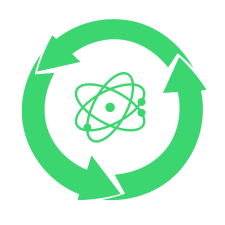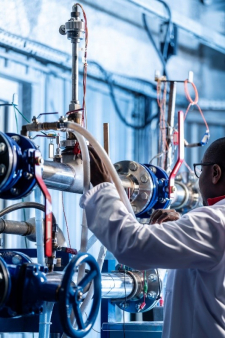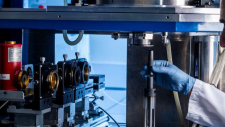
The growing demand for energy – and for low carbon electricity in particular – to fuel the electrification of end uses, the spread of digital technology and the surge in artificial intelligence has triggered a worldwide nuclear revival. In France, the President of the Republic and the Nuclear Policy Council have mapped out an ambitious development plan, setting the industry three major challenges: investment, innovation and waste management. Cutting edge metrology and industrial testing are being deployed to meet those challenges and to guarantee the absolute safety of installations.
Global energy demand, and electricity demand in particular, is booming. In 2024 total energy consumption rose by 2.2 % – almost twice the average of the previous ten years – and electricity consumption by 4.3 %, according to the International Energy Agency (IEA). Several factors lie behind this surge in electrons: the post‑Covid industrial rebound, ever‑greater need for air‑conditioning, and the electrification of end‑uses to combat climate change. In 2024, for example, sales of electric vehicles grew by more than 25 %, accounting for roughly 20 % of global new‑car sales; that share is expected to reach 50 % by 2030. Added to this is the rise of digital technology and AI: data‑centre electricity use is projected to double between 2022 and 2025.
Nuclear power: a worldwide renaissance
Against this backdrop, nuclear energy – long criticised – is now recognised as a future‑proof, carbon‑free solution, a status confirmed at COP28, where countries pledged to triple global nuclear capacity by 2050. In 2024 alone more than 8 GW of capacity was added and seven new reactors were connected to the grid. By early 2025, 62 reactors were under construction in 15 countries (half of them in China), representing more than 70 GW of future capacity.
The IEA’s January 2025 report(1) highlights the rise of small modular reactors (SMRs): over 80 designs are thought to be under development worldwide. Promising shorter construction times and lower costs, SMRs are attracting a growing number of governments – including India, the UK and France – and private companies keen to power their data centres and meet decarbonisation targets. In the United States, Google and Amazon will shortly source electricity from SMR start‑ups, while Microsoft has signed a deal to restart one of the historic reactors at Three Mile Island, Pennsylvania.
New competition from the East
The revival nevertheless poses questions for Western countries over the security of their fuel supplies (from Russia or sub‑Saharan Africa) and is fuelling intense technological and economic competition, led by Asia.
Already the leading builder of reactors at home, China is set to overtake the United States to become the world’s largest operator. India has the second‑largest pipeline of reactors under construction. The United Arab Emirates, Saudi Arabia, Bangladesh, Turkey, Kazakhstan, Uzbekistan and the Philippines are also joining the nuclear club. This eastern growth dynamic is reshaping the balance of power among the main exporters of nuclear technology. French specialists must now contend with stiff competition from the United States, Russia, South Korea and China.
France’s ambition takes shape
France fully intends to re‑energise its sector. In his landmark Belfort speech in 2022, President Emmanuel Macron announced a vast relaunch plan, including the construction of six EPR2 reactors by 2050 and the lifetime extension beyond 50 years of every reactor that can safely operate. The plan is enshrined in France 2030 investments and in the Act of 22 June 2023, which streamlines procedures for the six EPR2s – at Penly, Gravelines and Bugey – and authorises a further eight.
A further step came on 17 March 2025, when the Nuclear Policy Council (CPN) set a timetable and finance plan for the EPR2 programme : first reactor in service by 2038, lifetime extension to 60 years for the existing 56 reactors;, strategy to secure uranium resources and the modernisation of waste‑processing infrastructure.
The CPN also reaffirmed France’s interest in SMRs(2), notably by supporting Nuward, a pressurised‑water SMR designed to replace coal‑fired power stations and supply industrial and district heat; it is scheduled to be operational from 2030. Nuward benefits from France 2030 funding(3), as do other SMR projects (for example those of the start‑ups Calogena and Jimmy).
The Council has likewise revived studies into fast neutron reactors (FNRs), halted in 2019 (Astrid project). As fourth‑generation reactors, FNRs aim for greater safety and sustainability by closing the fuel cycle, thus conserving natural uranium resources. A first sodium‑cooled demonstration unit is envisaged around 2045.
The recycling question

On spent‑fuel treatment and recycling, the CPN confirmed ongoing investment in Orano’s "Aval du futur" programme at La Hague: construction of a treatment plant, a MOX fabrication plant using depleted uranium and recycled plutonium, and pools for interim storage of spent fuel.
Final‑stage (high‑level) waste remains confined within closely monitored facilities under the supervision of the National Agency for Radioactive Waste Management (Andra). The deep‑geological disposal site Cigéo at Bure, now under construction, is to enter a pilot industrial phase by 2027, with operation starting after authorisation around 2035.
France 2030 also funds, under Orano’s lead, an R&D programme on multi‑recycling in pressurised‑water reactors (MRREP), designed to increase the amount of recycled material loaded into French reactors.
Breakthrough SMR technologies offer further prospects for reducing both the volume and radiotoxicity of waste.
Industrial challenges
To align future industrial needs with emerging challenges, the French nuclear industry association (Gifen) launched the MATCH programme in 2023. This management tool aims to accelerate recruitment – estimated at around 100,000 over ten years – and to secure skills transfer in key areas such as boiler‑making, foundry work, welding, valves, radiological protection, testing and inspection.
A second major challenge is to restore the French sector’s operational excellence and its high standards of quality, safety and competitiveness – both to maintain and extend the life of the current fleet and to develop innovative technologies for EPR2s and SMRs.
Industry consensus is that innovation and R&D must be central, whether for designing new EPR2s and SMRs, developing future FNRs or molten‑salt reactors (MSRs), or advancing construction processes and analytical/testing tools for components and installations.
High‑end metrology and industrial testing: keys to safety
To support equipment manufacturers, operators and service providers in the French nuclear sector, LNE meets their advanced metrology and testing requirements. Its nuclear‑focused expertise enables it to offer a range of services: equipment calibration, metrological qualification and robustness testing; thermal characterisation of materials; monitoring of cooling‑water discharge temperatures; and technical assistance and training.

In collaboration with EDF, LNE has refurbished its temperature‑probe qualification rig, which evaluates probe response times by subjecting them to 11 °C steps (from 50 °C to 61 °C) using two thermostatically controlled water loops. LNE also performs robustness tests (climatic, mechanical, physico‑chemical, vibration, EMC) on equipment installed in plants, and has helped improve the accuracy of “intelligent” systems such as high‑precision welding stations.

LNE recently measured the thermal conductivity up to 330 °C of metallic materials for heat‑exchanger tubes, carried out failure analysis on high‑temperature materials for Orano, and performed fire tests for CEA and EDF in the context of fire‑safety engineering.
As the current reactors are extended and new ones built at Penly, Gravelines and Bugey, LNE is expected to qualify metrology and robustness of measurement systems, and is also exploring automated calibration and remote self‑assessment for future EPR2s and SMRs.

Partners since 2011, LNE and Andra jointly develop methods and devices for calibrating and monitoring measurement instruments (sensors, probes, etc.) used to observe and survey radioactive‑waste repositories. They have designed in‑situ calibration systems for fibre‑optic temperature sensors tested 500 m underground in Andra’s research laboratory, and have optimised the surface‑water quality monitoring set‑up in readiness for Cigéo.
Temperature rise in the host structure is a key waste‑monitoring parameter. With their partnership extended to 2027, LNE and Andra are working on next‑generation probes and innovative data‑processing technologies, potentially incorporating AI algorithms.
Within French metrology, the Henri Becquerel National Laboratory (LNE‑LNHB) continues research on waste radioactivity. Recent work with Andra on site decontamination has produced reference standards for surface‑contamination monitors, helping to secure the waste inventory so that material is channelled to the correct management route.
[File published in July 2025]
References :
[1] IEA report : The Path to a New Era for Nuclear Energy
[2] French Nuclear Safety (ASN)
[3] France 2030 programme : winners of the "Innovative Nuclear Reactors" scheme (in french only)





